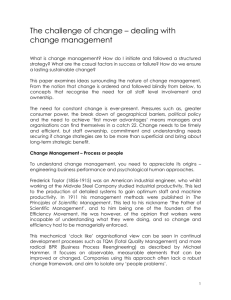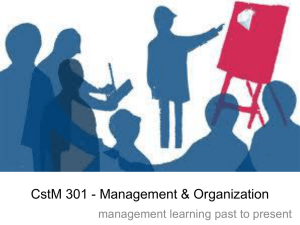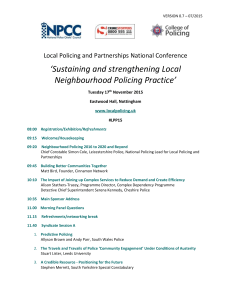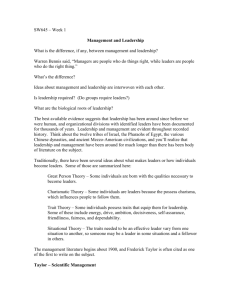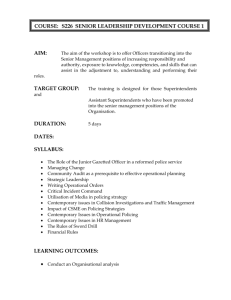law enforcement departments as learning organizations
advertisement
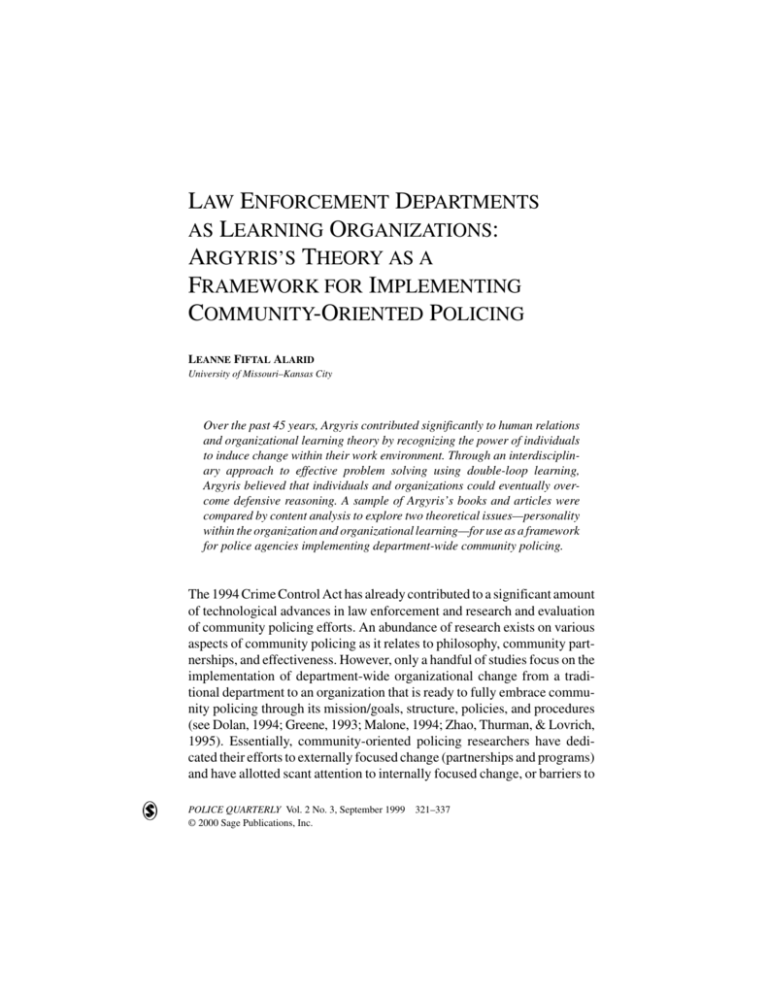
Alarid / ARGYRIS’S THEORY POLICE QUARTERLY (Vol. 2, No. 3, September 1999) LAW ENFORCEMENT DEPARTMENTS AS LEARNING ORGANIZATIONS: ARGYRIS’S THEORY AS A FRAMEWORK FOR IMPLEMENTING COMMUNITY-ORIENTED POLICING LEANNE FIFTAL ALARID University of Missouri–Kansas City Over the past 45 years, Argyris contributed significantly to human relations and organizational learning theory by recognizing the power of individuals to induce change within their work environment. Through an interdisciplinary approach to effective problem solving using double-loop learning, Argyris believed that individuals and organizations could eventually overcome defensive reasoning. A sample of Argyris’s books and articles were compared by content analysis to explore two theoretical issues—personality within the organization and organizational learning—for use as a framework for police agencies implementing department-wide community policing. The 1994 Crime Control Act has already contributed to a significant amount of technological advances in law enforcement and research and evaluation of community policing efforts. An abundance of research exists on various aspects of community policing as it relates to philosophy, community partnerships, and effectiveness. However, only a handful of studies focus on the implementation of department-wide organizational change from a traditional department to an organization that is ready to fully embrace community policing through its mission/goals, structure, policies, and procedures (see Dolan, 1994; Greene, 1993; Malone, 1994; Zhao, Thurman, & Lovrich, 1995). Essentially, community-oriented policing researchers have dedicated their efforts to externally focused change (partnerships and programs) and have allotted scant attention to internally focused change, or barriers to POLICE QUARTERLY Vol. 2 No. 3, September 1999 © 2000 Sage Publications, Inc. 321–337 322 POLICE QUARTERLY (Vol. 2, No. 3, September 1999) change within the organization itself (Zhao et al., 1995, p. 14). Through a nationwide survey of police chiefs, Zhao et al. found that internal organizational barriers were of more concern to administrators than relationships with the community. As researchers have consistently found, organizational readiness is necessary to maintain community policing as a core purpose of police in our society (Rosenbaum, Yeh, & Wilkinson, 1994, p. 350). For law enforcement personnel to fully support organizational changes to community policing and for organizations to implement and sustain these improvements, the learning process must be an essential and integral component of the entire organization (Geller, 1997). Senge (1990) called these places of employment “learning organizations.” A learning organization is “an organization that is continually expanding its capacity to create its future” (Senge, 1990, p. xv). To create a learning organization in criminal justice, particularly in law enforcement departments, it is important to explore the theoretical underpinnings of human relations theory tied to organizational learning. In law enforcement administration, the human relations perspective focused on individual needs within the organization, a preference for an informal style of organizational interaction, and a concern for motivating factors to improve productivity in the workplace. Human relations encouraged such participative management practices as quality circles, problem-solving groups, and vertical staff meetings for more effective organizations (Gaines, Kappeler, & Vaughn, 1997). Participative management styles are one of the fundamentals of the learning organization and of the community-oriented policing philosophy. Research found that police officers, supervisors, and administrators supported the use of participative management in policing (Witte, Travis, & Langworthy, 1990; Wycoff & Skogan, 1994). Not all research, however, found such a smooth transition to community policing. Malone (1994) examined why law enforcement officers, supervisors, and police chiefs resisted inevitable organizational change by measuring different modes of thinking. Malone found that the majority of police chiefs lacked an integrative and futuristic approach to planning. These findings did not explain why these modes of thinking were absent and how to change shortcomings in thinking that impeded change. Dolan (1994) examined organizational “internal backlash” characteristics that accompanied organizational change to community policing, such as professional jealousy, problems with staff recruitment and training, and change resistance. Sadd and Grinc (1994) found that common organizational problems included lack of middle management assistance and endorsement, Alarid / ARGYRIS’S THEORY 323 which contributed in part to patrol officer confusion about the purpose and significance of community policing. Of all the studies examining internal organizational change barriers, the suggestions for change were not based on theoretical reasons for why these behaviors occurred in the first place. A human relations theoretical framework is meaningful to make sense of why the suggestions proposed by Dolan (1994) are important. Of all the human relations theorists—including Douglas McGregor (1960), Abraham Maslow (1954), Frederick Herzberg (1968), and Rensis Likert (1967)— Chris Argyris was best known for his principles of organizational learning (Kennedy, 1991). Thus, this research will focus on the works of Argyris to draw attention to an organizational theorist not commonly cited in criminal justice literature. Although Argyris never specifically wrote on community policing or law enforcement, his theories can be applied to any type of agency. Argyris’s ideas later served as the basis of Senge’s (1990) learning organization. The central argument of this article is that organizational learning is a necessary component of organizational change, such as that of altering traditional law enforcement organizational structure to community-based policing. Based on this premise, it is important to examine the theoretical roots of the learning organization. METHODS Content analysis and comparative methods were used to analyze a sample of 18 journal articles and four books authored by Argyris that spanned a 40-year period from 1957 to the present. Each published work was examined for general content, central issues, and whether earlier writings had a different flavor from later writings. When major themes emerged, a representative sample of articles were drawn to more specifically identify the theoretical framework. Argyris’s two themes, that of personality within the organization and organizational learning, will be explored to answer the following question: How can individual personality within the organization and organizational learning be used as a theoretical framework for law enforcement agencies that are in the process of change from a traditional department to a philosophy of community policing? PERSONALITY AND THE ORGANIZATION One of Argyris’s (1957) classic books, Personality and Organization, predated the works of most other human relations thinkers and writers of the 324 POLICE QUARTERLY (Vol. 2, No. 3, September 1999) time. Two of his later books, Integrating the Individual and the Organization (1964) and Organization and Innovation (1965), further cultivated personality and organization theory. Argyris (1973, 1974) specified two theoretical assumptions of personality and organization theory. The first assumption was that organizations have a life of their own. Organizations exist because goals become too complex for one individual to achieve. Large traditional organizations are inflexible in supporting individual change and growth and encourage dependence, apathy, and compliance. A second assumption was that individual traits, abilities, and needs exist on a continuum rather than in a vacuum. This means that individuals are complex and have changing needs requiring appropriate organizational responses to fulfill individual maturational perspectives. These two assumptions also fit the community policing philosophy, which assumes not only that the individual worker has changing needs inside the organization but that the outside community in which the officer serves has unique problems and developments. Personality and organization theory focused on both the individual and macro levels. This theory was also interdisciplinary because it combined psychology and sociology in an administrative context. Argyris merged a symbolic interactionist approach of the individual worker with the influence of the organizational workplace. To measure how individual worker personality is affected by the organization, Argyris observed how a manager reacted to actions of individual workers and how subordinates responded to the manager’s initial reaction. The ideal subordinate reaction, termed a mode of worker adaptation, contributed to maintenance of good work habits and positive growth and development. Unhealthy organizations, on the other hand, had workers who responded negatively to managers by behaving apathetically, using defense mechanisms, actively fighting the organization (i.e., creating a union or striking), or leaving for another job. As one of the first authors to use the term organizational behavior in print, Argyris stressed the disharmony and dissatisfaction of the individual within a traditional organization. He predicted that the individual worker would be more satisfied when a more productive relationship between the individual and the organization existed. However, Argyris (1973) argued that organizations developed this relationship in an inappropriate way by adding work responsibilities through job enlargement. Alarid / ARGYRIS’S THEORY 325 JOB ENLARGEMENT Job enlargement was originally designed to increase an individual’s feeling of importance while circumventing worker passivity and organizational dependence. Many city-supported agencies, including local law enforcement departments, expanded the beat officer’s job so that the officer would feel valued. Job enlargement was used during the professional “super cop” era of August Vollmer and O. W. Wilson in the 1920s. Although technological advances such as the telephone, two-way radio, and the automobile assisted officers, political pressures mounted to improve the image and performance of the police. The police officer role continued to expand through the 1960s as society became increasingly dependent on the police to solve its problems. Yet a 1969 Chicago survey found that when compared with other city employees, Chicago police officers had lower morale and trust in their employer. Researchers in the study questioned the feasibility of the police military model to meet the needs of the modern organization (Franz & Jones, 1987). Research found that job enlargement did not significantly increase the overall quality of life at work because job enlargement expanded responsibilities across the departmental hierarchy but did not increase autonomy and independence (Argyris, 1973). If we applied this line of inquiry to the development of community policing, job enlargement might be an outcome if community policing is initially developed as an auxiliary unit rather than department-wide. As an auxiliary unit, a small number of community officers may tend to feel overworked and underappreciated, especially if this unit is assigned code enforcement, grants, and any community-related project that does not involve immediate arrest. Policing in this context may not be understood by other law enforcement officers in the same department who view themselves as performing the “real police work.” Organizational theorists such as Herzberg recognized the downfall of job enlargement. Herzberg (1968) developed the idea of job enrichment as a way of increasing individual worker satisfaction. JOB ENRICHMENT Job enrichment linked work duties to Maslow’s (1954) higher order needs of autonomy, self-respect, recognition, achievement, individual growth, and status. Argyris concurred with Herzberg’s (1968) ideas about 326 POLICE QUARTERLY (Vol. 2, No. 3, September 1999) job enrichment, and proceeded one step further. The job should be enriched vertically so that it “enhances opportunity for the employee to experience greater autonomy and control . . . lengthens the time perspective, and decreases dependence and submissiveness upon the superior” (Argyris, 1973, p. 150). Studies on job enrichment in policing suggest that the job could be enriched by improving the quality of equipment, providing motivators for professional growth, recognizing achievement, and increasing officer input in decision making to decrease role stress, role conflict, and alienation (Johnson, 1993; Souryal, 1981). An example of utilizing job enrichment techniques in one federal law enforcement records unit increased worker productivity by 63%, decreased absenteeism by 20%, and cut job turnover in half (Witham & Mitchell, 1985). How can community-oriented policing be internally structured and sustained to enrich the job of the street officer? Argyris would contend that community policing must be initiated department-wide, so that all officers are community police officers. Though job enrichment has been successful in some areas of law enforcement, personality and organization theory did not answer the question of why organizations and the workers within them are slow to change to ideas and practices that are likely to increase job satisfaction, worker productivity, and decrease turnover. What were the factors behind organizations that were slow to change? Because it was not the organization itself that was slow to change but the individuals inside the organization who impeded progress, the next step was to determine the reasons why some individuals inside organizations did not change, grow, and learn. In other words, why do some officers resist the change and sometimes attempt to sabotage a department-wide change to community policing? In an attempt to explain individual change resistance, Argyris and Schon (1974) formally expanded personality and organization assumptions into a theory of organizational learning that incorporated such concepts as espoused theories of action, theories-in-use, single-loop learning, double-loop learning, and an individual’s master program. ORGANIZATIONAL LEARNING THEORY Argyris devoted the greatest proportion of his research to developing and testing concepts that distinguished various types of individual learning and their subsequent influence on behavior. Argyris (1976a) defined learning as “the detection and correction of errors” (p. 365). Error detection and Alarid / ARGYRIS’S THEORY 327 correction had to be present together or else the learning process would be inhibited. Furthermore, the amount and quality of learning depended on two factors: (a) the amount of valid information available to monitor a decision and (b) the existence of feedback. In many departments, community police officers are still evaluated on traditional measures, such as arrest rates and clearance rates. The individual, Argyris would argue, is not receiving the proper feedback by the organization. Argyris’s theory of organizational learning can be best explained by examining the following three concepts: (a) theories of action versus theories-in-use, (b) single- loop versus double-loop learning, and (c) organizational defensive routines. THEORIES OF ACTION VERSUS THEORIES-IN-USE In their book, Argyris and Schon (1974) distinguished between espoused theories of action and theories-in-use. Espoused theories of action were philosophies of behavior that consciously guided individual actions. In contrast, theories-in-use were unconscious and predictable reactions or mental models determined by how people actually behave. The ideal goal is for every worker in the organization to make their theories-in-use the same as their espoused theories of action. Argyris (1982b) explained the difference between the two theories in this way: “Although people do not behave congruently with their espoused theories [what they say], they do behave congruently with their theories-in-use [their mental models]” (p. 159). For example, in law enforcement, an espoused theory of action would be the training that new officers receive in the police academy. A theory-in-use, then, would be the classic example of the field training officer who tells the new recruit to “forget everything you learned in the academy.” According to Argyris, workers with incongruencies between their espoused theories and theories in use typically fall in two categories: either they were not cognizant of their own discrepancies or they were aware of the inconsistency but refused to change. When asked, most employees reported that their coworkers had theories-in-use that were incongruent with espoused theories in action (Argyris, 1975, 1976b, 1982a). Being unaware was first thought to be caused by lack of feedback or a lack of training about consistent values and behaviors. When both of these reasons were refuted, Argyris and his colleagues turned to refusal to change as the main reason why workers and managers who had received in-service training reverted back to their old habits and ways of thinking in the workplace. In other 328 POLICE QUARTERLY (Vol. 2, No. 3, September 1999) words, in a police department that is undergoing a change to community policing for the first time or in an agency that is attempting to progress toward a department-wide community police strategy, why do some frontline and ranking officers, after having received training through seminars and workshops, knowingly return to traditional law enforcement philosophies and behaviors? Argyris (1976a) concluded that theories-in-use were the most powerful barrier to organizational change. He elaborated on three possible consequences of the hidden power of theories-in-use. First, people are perceptive to the fact that they are being manipulated and controlled. Thus, working environments tend to become more secretive and people are more apt to behave in ways that move away from values that they genuinely support. A second reason why theories-in-use continue to be applied is that new learning behaviors are difficult to test. The most pervasive reason was that even when individuals know their old problem-solving methods are ineffective, they continue to use these same methods because they are familiar, comfortable, and do not require conscious effort to change. In organizational learning theory, one reason why some departments claim that they are doing community policing but have not changed the essential components to fully implement a lasting philosophy is that the key individuals in the organization have not changed their old theories-in-use to new community policing theories of action. The key players of the police department to initiate organizational change begins at the top. To further illustrate the applicability of the learning concepts, Argyris also introduced Model I /single-loop and Model II /double-loop learning. SINGLE-LOOP VERSUS DOUBLE-LOOP LEARNING Model I theories-in-use are directly connected with single-loop learning, the predominant model of most formal organizations including the military model used in law enforcement. A single-loop learning environment is laden with secrecy, unspoken mistrust between workers and supervisors, defensiveness, unilateral control, and implicit loyalty to the boss (Argyris, 1976a; Franz & Jones, 1987). In unhealthy single-loop organizational environments, unilateral control, the “mini- Machiavellian” style of leadership, inhibited adequate feedback and contributed to poor decision making. As a result of the perceptions of the decision-making process, top administrators reacted by further tightening control and secrecy (Argyris, 1976a). Alarid / ARGYRIS’S THEORY 329 To avoid the negative consequences of a single-loop environment, Argyris presented a double-loop model of learning. Double-loop learning, or Model II behavior, consists of valid information, adequate feedback, internal commitment, and free and informed choice. Furthermore, unilateral leadership is replaced by an open confrontation management style, such as participatory management, to comprehensibly explore a wide range of options and make the most effective decision possible. The goal, then, in Argyris and Schon’s (1974) organizational learning theory was to start with the individual by synthesizing personality and organization theory into a learning model. In other words, individuals had to learn how to change Model I behavior to Model II behavior by means of double-loop learning. To move from Model I to Model II behavior, it was strongly recommended that individual workers and managers enlist the help of an outside interventionist expert to recognize and question their own theories-in-use. In this way, the experienced consultant would work with small groups of people or alone with each individual in a neutral manner irrespective of rank or position in the department. Through his training experiences with organizations of different sizes and types, Argyris (1975) found that most upper level administrators had the capability to “develop irreversible changes toward Model II with four weeks of full-time training” (p. 485). This was the case because the vast majority of job behavior was assumed to be a product of the work environment rather than an innate trait. It is interesting to note that Argyris found that people in top management positions learned double-loop methods at the same rate as line workers. Thus, the rate of learning depended not on organizational position but on individual desire to change inconsistent espoused theories of action that control behavior. In an effort to further refine how to change at both the individual and organizational levels, Argyris (1983) introduced action science, a philosophy influenced by the work of Lewin (1952). In the action science plan, Model I theories needed to be “unfrozen” to learn the desirable Model II behavior. Learning occurred “whenever a match exists between intentions and outcomes and/or an individual detects and corrects an error—a mismatch—between intention and outcome” (Argyris, 1982b, p. 116). The ultimate goal of learning using action intervention was to know the appropriate situation to invoke Model I or Model II behavior. These concepts assure us that in any organization wishing to make a change, including police agencies, changing philosophical thinking and behavior inconsistencies must start at the top and descend by rank. Argyris also supports the use 330 POLICE QUARTERLY (Vol. 2, No. 3, September 1999) of an outside consultant to work individually with each employee and in small groups to make these changes. Argyris stresses the importance of change in all areas of the organization: selection, hiring, initial training, organizational mission, organizational goals and objectives, in-service training, and evaluation for promotion and/ or merit. The intended change will not be achieved if any one of the areas and/or individuals of the organization are not fully altered. For example, some departments neglect the integration of community policing in the full academy training. Rather, these departments retain the existing structure of the academy, merely adding a section on community policing. Other departments neglect the evaluation component. Rather than evaluating officers on numbers of problems solved, annual community surveys, and/or the contribution of problem solving to calls for service or the crime rate, officers are evaluated on traffic citations, arrest rate, and index crimes. Many top officials in organizations say they are “doing community policing,” but one or more of the essential organizational components to make this philosophical transition is missing. The next section builds on Argyris’s learning theory by addressing his later research on barriers to valid information for effective organizational decision making. ORGANIZATIONAL DEFENSIVE ROUTINES In 1985, Argyris first introduced the concept of organizational defensive routines as a chief obstacle against change toward Model II behavior. Organizational defensive routines are “routinized policies or actions intended to prevent the experience of embarrassment or threat” (Argyris, 1987, p. 456). Defensive routines are not to be confused with such individual defense mechanisms as denial, suppression, repression, displacement, and cognitive dissonance. Organizational defensive routines produced distorted or mixed messages or “noise” over truthful, valid information required of Model II behavior. Noise can be produced by either individual defense mechanisms or organizational defensive routines, despite the fact that new workers are hired to replace workers who leave the organization. An example of noise in policing is the powerful influence of the officer occupational subculture. Codes and norms such as cynicism, rigidity, authoritarianism, and conservatism remain a large part of this impervious “Blue Code of Secrecy” that is reinforced by peer pressure (Skolnick, 1994). Many of these characteristics create a situation that makes change Alarid / ARGYRIS’S THEORY 331 very difficult, especially because individual officers who operate outside the blue code are ostracized by coworkers. To demonstrate the harmful effects of organizational defensive routines in the corporate world, Argyris used the case study method to design and implement a learning strategy to be used by company leaders. The goal of the strategy was to decrease organizational defensive routines and become aware of discrepancies in individual thinking and behaviors. Argyris believed that reasoning productively should begin at the top and continue through the hierarchy to achieve overall organizational change. The first step, therefore, was for leaders to acknowledge that organizational defensive routines existed in their organization. Second, leaders needed to be supportive of the idea that all individuals had inner discrepancies between beliefs and actions. The overall goal of the training, therefore, was to produce lasting change on both individual and organizational levels. While further explaining the shortcomings of organizational defensive routines, Argyris (1989) explained mental models or master programs that all individuals have as coping strategies for embarrassing or threatening situations. Although training will not erase individual master programs, individuals who are motivated to change will learn how to reason productively. Productive reasoning meant that workers and managers separated personal experiences and biases from the logical process of decision making at work. In this way, a decision was open to scrutiny and questioning by others as to what factors affected how the solution was attained. If the work environment is already based on double-loop learning, the decision maker will not feel threatened by other colleagues or officers who question the decision openly and honestly. Analytical analysis or productive reasoning was found to be more effective than when individuals attempted to control a threatening situation (Argyris, 1990). Furthermore, workers who are not threatened by questioning also develop strong beliefs of self-efficacy, attempt to master challenging tasks, and optimistically view error as an opportunity to learn from past mistakes (Argyris, 1990). In this way, goals are accomplished and individuals feel a sense of control over the outcome. What this means for police organizations is that department leaders have to be willing to acknowledge that the officer subculture exists and to use the subculture to support the initial change to community policing. Obtaining group support is important, but the training must be on an individual level or by using small groups of people who are not members of the same subcultural group (e.g., mixing officers from different shifts/divisions or mixing sworn officers with civilian personnel, different departments, and/or various ranks). 332 POLICE QUARTERLY (Vol. 2, No. 3, September 1999) Grouping people who are less familiar with each other is advantageous because there typically is less reputation to protect. If an attempt is made to break the subculture apart, officers will more adamantly resist the change. This approach would support Lord’s (1996) study, which found that the higher the level of social support, the greater the individual ability to cope with job stressors associated with organizational change. In some organizations, however, the subculture is so harmful to the department that it must be disbanded before any positive change can occur at the individual level. In two articles, “Education for Leading-Learning” (1993) and “Teaching Smart People How to Learn” (1991), Argyris devoted a practical guide to teaching top administrators (such as police chiefs) how to overcome learning blocks, defensive reasoning, and how to turn energy toward genuine openness and overcoming a fear of failure. Research findings indicated that the most successful administrators and managers tend to have high motivation and aspirations for success. However, unlike most people, top executives are “productive loners” and have not experienced the embarrassment and threat that comes with failure. When faced with the possibility of failure, some of the most motivated and productive individuals tend to fall apart because they lack productive reasoning skills (Argyris, 1991, 1993). Argyris (1993) offered productive people with practical solutions. By combining his research on a sample of almost 6,000 individuals studied in the past 20 years, Argyris (1993) found that regardless of personality traits, age, gender, ethnicity, education, and position in an organization, the vast majority of individuals had difficulties in dealing with double-loop learning. Furthermore, organizations and managers in both capitalist and socialist countries had the same problems with organizational noise, invalid information, and single-loop learning (Argyris, 1978). Argyris’s research supports the fact that learning problems in American organizations are not a product of capitalism, nor do organizational defensive routines exist in isolation in this country. Many of the solutions Argyris provides are applicable to both profit and nonprofit organizations around the world. DISCUSSION Community policing has been one of the most pervasive organizational changes in policing in the past decade. The purpose of this article was to provide a theoretical framework for explaining organizational barriers to change. Argyris’s theory of individual personality within the organization and organizational learning was suggested as a theoretical framework for Alarid / ARGYRIS’S THEORY 333 law enforcement agencies in the process of adapting to community policing philosophies and practices. In particular, Argyris’s theory suggests why organizational change is important, possible barriers to organizational change, and suggestions for overcoming change barriers. Once these obstacles are identified and understood, members of the organization can then learn how to conquer their own inconsistencies before motivating others. Organizational change is important to transform a Model I, single-loop learning environment to a Model II, double-loop learning work environment. As a result of double-loop learning, Model II behaviors encourage independent action based on valid information and free choice. The decision maker does not feel threatened by other officers or supervisors who question their decision openly and honestly. Because there is a theoretical presumption that learning leads to changes in actions and not merely comprehending new information, when individuals learn Model II behaviors of questioning routines and outcomes, change is hypothesized to occur at the organizational level. That is why recognizing the gap in what officers say (theories-in-use) and what they do (theories in action) is critical to the learning process. Until this happens, no learning and lasting change will occur at either the individual or the organizational level. Well-planned, gradual change was viewed in this study as the least disruptive and most productive way toward organizational change. Incremental, piecemeal change was supported for departments implementing community policing (Strecher, 1997). Before implementing a department-wide change to community policing, departments may wish to collect information about officer attitudes so that individuals who are more resistant to change can be identified (Lurigio & Skogan, 1994). Furthermore, a baseline study of such organizational factors as work environment, coworker relations, managerial relations, and job satisfaction is meaningful. Argyris’s theory suggests that organizational factors have more impact on work satisfaction and worker adaptation than individual characteristics (Argyris, 1957). This study explored the main reasons for organizational resistance. Two reasons why some departments claim they are doing community policing but have not changed the essential components to fully implement a lasting philosophy is first, despite training in what community policing is, key individuals in the organization have not committed themselves to changing their old theories-in-use to new community policing theories of action. A change parameter resulting from this theory is that reasoning productively starts at the top and continues through the hierarchy to achieve overall 334 POLICE QUARTERLY (Vol. 2, No. 3, September 1999) organizational change. Leaders must first admit that organizational defensive routines exist in their organization, and they should also support the idea that all individuals, including themselves, have inner discrepancies between beliefs and actions. It is recommended that department chiefs be the initial change instigators and not leave the implementation responsibility to other coworkers. Police chiefs should also manage the speed at which the incremental change occurs (Glensor & Peak, 1996). Second, organizational defensive routines, which prevent the experience of individual embarrassment or threat, trap otherwise intelligent officers and administrators into a state of skilled incompetence (Argyris, 1985). People who are in a state of skilled incompetence never expose their own thinking out of fear that others will find errors or to protect someone else from criticism. Thus, skilled incompetence workers also prevent group learning and contributions to groupthink. Furthermore, the blue code of secrecy dictates that officers should protect and tolerate other officers at all times, even when some have engaged in misconduct. To go against this code and embarrass or expose incongruent behaviors of fellow officers creates a stressful and isolated existence for individuals who wish to act as change agents. To overcome these barriers to change, Argyris’s theory suggests that individuals recognize and question their own theories-in-use and conquer their own skilled incompetence with the help of an outside interventionist expert. Organizational learning can be used at all levels in the organization and it is possible for anyone in any position to decrease discrepancies in their own behavior. A final change principle for the learning organization is through team building and collective learning to recognize when people are not reflecting on their own assumptions, when they are not inquiring into each other’s thinking, when they are not exposing their thinking in a way that encourages others to inquire into it. . . . It is not the absence of defensiveness that characterizes learning teams but the way defensiveness is faced. (Senge, 1990, pp. 256-257) How can these theoretical concepts be applied to research in criminal justice agencies? To study organizational phenomena, criminal justice researchers should be aware of the existence of theories of action (what should be happening) and theories-in-use (what is really happening). This underscores the need to understand the organization before the survey or interview instrument is developed so the researcher is clear on the nature and extent of the problem. Alarid / ARGYRIS’S THEORY 335 Researchers conducting future studies within criminal justice agencies may wish to pay closer attention to internal organizational factors as important determinants in inducing change in worker job satisfaction and police community relations. Most importantly, researchers should not overlook Argyris’s most central premise of all—the capability of the individual to induce lasting and productive organizational change. Must all departments change their philosophy to community policing? Argyris’s theory suggests that police departments would have more productive and satisfied workers making more effective organizational decisions if police departments moved away from the military model, which Argyris would most likely consider an archetype of futile, empty, and unproductive Model I learning. At the same time, Argyris’s theory does not suggest that community policing is the only direction for organizational change. Argyris’s theory of organizational learning challenges administrators and researchers to consider that police departments can be learning organizations by creating a functional Model II, double-loop learning environment and achieving an institutionalized philosophy of community policing. REFERENCES Argyris, C. (1957). Personality and organization. New York: Harper. Argyris, C. (1964). Integrating the individual and the organization. New York: John Wiley. Argyris, C. (1965). Organization and innovation. Homewood, IL: Irwin. Argyris, C. (1973). Personality and organization revisited. Administrative Science Quarterly, 18, 141-167. Argyris, C. (1974). Personality vs. organization. Organizational Dynamics, 3, 2-17. Argyris, C. (1975). Dangers in applying results from experimental social psychology. American Psychologist, 30, 469-485. Argyris, C. (1976a). Single-loop and double-loop models in research on decision making. Administrative Science Quarterly, 21, 363-375. Argyris, C. (1976b). Theories of action that inhibit learning. American Psychologist, 31, 638-654. Argyris, C. (1978). Is capitalism the culprit? Organizational Dynamics, 6, 20-37. Argyris, C. (1982a). The executive mind and double-loop learning. Organizational Dynamics, 11, 5-22. Argyris, C. (1982b). Reasoning, learning and action: Individual and organizational. San Francisco, CA: Jossey-Bass. Argyris, C. (1983). Action science and intervention. Journal of Applied Behavioral Science, 19, 115-135. Argyris, C. (1985). Strategy, change, and defensive routines. Boston: Pitman. Argyris, C. (1987). Bridging economics and psychology: The case of the economic theory of the firm. American Psychologist, 42, 456-463. 336 POLICE QUARTERLY (Vol. 2, No. 3, September 1999) Argyris, C. (1989). Strategy implementation: An experience in learning. Organizational Dynamics, 18, 5-15. Argyris, C. (1990). Inappropriate defenses against the monitoring of organization development practice. Journal of Applied Behavioral Science, 26, 299-312. Argyris, C. (1991). Teaching smart people how to learn. Harvard Business Review, 69, 99-109. Argyris, C. (1993). Education for leading learning. Organizational Dynamics, 21, 5-17. Argyris, C., & Schon, D. (1974). Theory in practice. San Francisco, CA: Jossey-Bass. Dolan, H. P. (1994). Coping with internal backlash. Police Chief, 61, 28-32. Franz, V., & Jones, D. M. (1987). Perceptions of organizational performance in suburban police department—A critique of the military model. Journal of Police Science and Administration, 15, 153-161. Gaines, L. K., Kappeler, V. E., & Vaughn, J. B. (1997). Policing in America (2nd ed.). Cincinnati, OH: Anderson. Geller, W. A. (1997, December). Suppose we were really serious about police departments becoming learning organizations? National Institute of Justice Journal, 2-8. Glensor, R., & Peak, K. (1996). Implementing change: Community-oriented policing and problem solving. FBI Law Enforcement Bulletin, 65, 14-21. Greene, H. T. (1993). Community-oriented policing in Florida. American Journal of Police, 12, 141-155. Herzberg, F. (1968). One more time: How do you motivate employees? Harvard Business Review, 46, 53-62. Johnson, R. A. (1993, January). Culture, mission, and goal attainment. FBI Law Enforcement Bulletin, 24-25. Kennedy, C. (1991). Instant management. New York: William Morrow. Lewin, K. (1952). Group decision and social change. In T. M. Newcomb & E. L. Hartley (Eds.), Readings in social psychology (2nd ed., pp. 459-473). New York: Holt and Company. Likert, R. (1967). The human organizations. New York: McGraw-Hill. Lord, V. (1996). An impact of community policing: Reported stressors, social support, and strain among police officers in a changing police department. Journal of Criminal Justice, 24, 503-522. Lurigio, A. J., & Skogan, W. G. (1994). Winning the hearts and minds of police officers: An assessment of staff perceptions of community policing in Chicago. Crime and Delinquency, 40, 315-330. Malone, M. V. (1994). Key thinking strategies for future problem solving. Police Chief, 61, 29-35. Maslow, A. H. (1954). Motivation and personality. New York: Harper. McGregor, D. (1960). The human side of enterprise. New York: McGraw-Hill. Rosenbaum, D., Yeh, S., & Wilkinson, D. (1994). Impact of community policing on police personnel: A quasi-experimental test. Crime & Delinquency, 40, 331-353. Sadd, S., & Grinc, R. (1994). Innovative neighborhood oriented policing: An evaluation of community policing programs in eight cities. In D. Rosenbaum (Ed.), The challenge of community policing (pp. 27-52). Thousand Oaks, CA: Sage. Alarid / ARGYRIS’S THEORY 337 Senge, P. M. (1990). The fifth discipline: The art and practice of the learning organization. New York: Doubleday. Skolnick, J. H. (1994). Justice without trial: Law enforcement in democratic society (3rd ed.). Englewood Cliffs, NJ: Macmillan. Souryal, S. S. (1981). Kojak Syndrome—Meeting the problem of police dissatisfaction through job enrichment. Police Chief, 48, 60-64. Strecher, V. G. (1997). Planning community policing. Prospect Heights, IL: Waveland. Witham, D. C., & Mitchell, D. T. (1985). Higher performance through organization development. FBI Law Enforcement Bulletin, 54, 7-11. Witte, J. E., Travis, L. F., & Langworthy, R. H. (1990). Participatory management in law enforcement: Police officer, supervisor, and administrator perceptions. American Journal of Police, 9, 1-23. Wycoff, M. A., & Skogan, W. G. (1994). Effect of a community policing management style on officers’ attitudes. Crime & Delinquency, 40, 371-383. Zhao, J., Thurman, Q. C., & Lovrich, N. P. (1995). Community-oriented policing across the U.S.: Facilitators and impediment to implementation. American Journal of Police, 14, 11-28. Leanne Fiftal Alarid is an assistant professor in the Department of Sociology/Criminal Justice & Criminology at the University of Missouri–Kansas City. She received her Ph.D. in criminal justice from Sam Houston State University in 1996. She has published manuscripts in Justice Quarterly, Journal of Research in Crime and Delinquency, Policing, and Journal of Correctional Health Care. Her current research interests include community policing, theory, women offenders, and correctional policy.


